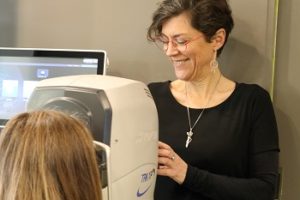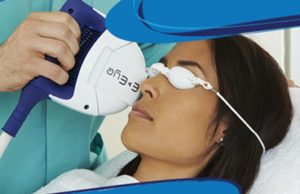
Dry eye syndrome (DES) is a chronic condition that develops when your eyes do not produce and maintain enough tears to keep the eye’s surface lubricated resulting in multiple symptoms that range from person to person. DES can be due to a reduction in tear production or increased tear evaporation from a lack of lipid in the tears that stem from oil glands in the eyelids. The effects can range from minor dryness and discomfort to pain, blurred vision and frequent eye infections.
Symptoms of Dry Eye
Symptoms of dry eye syndrome can vary depending on the severity of the condition but can include:
- Dry, itchy eyes
- Burning or stinging
- Irritation
- Sticky or watery eyes
- Blurred vision
- Pain
- Foreign body sensation
The main function of tears is to maintain the health of the cornea of your eye by washing away foreign matter and ensuring that the surface of your eye remains moist, smooth and clear. Tears also rinse away dust particles from your eyes and contain enzymes that protect your eyes from bacteria that can cause infections. Dry eyes is a condition that develops when the quality of tears produced is not sufficient to maintain the moisture balance in your eye. This can result in that scratchy sensation, a continuous feeling of dryness, stinging and a sensation of a foreign body in your eye. Ironically in an effort to fight off the condition, dry eyes can cause you to produce excessive tears, which is why some people experience watery eyes.
Causes of Dry Eye
Dry eyes can occur naturally as a result of ageing or hormonal changes, typically in women who are pregnant, taking oral contraceptives or going through menopause. In fact, women over 50 have a 50% greater risk of dry eye disease than men do of the same age. It can also result from taking certain medications that reduce tear production such as antihistamines, blood pressure medications and antidepressants. Environmental factors can also play a role in drying out the eyes and DES is common in areas where the climate is dry, dusty and windy. Home air conditioners or heating systems and excessive time spent staring at a computer or television screen can also dry out eyes and exacerbate symptoms due to the lack of blinking while staring at our screens.
Individuals that suffer from certain medical conditions such as diabetes, blepharitis, lupus, arthritis and thyroid problems are more vulnerable to developing DES. Other causes can be due to eye surgery including LASIK, certain conditions in which the eyelids don’t close properly or extended contact lens use.
Diagnosis of Dry Eye Syndrome
Typically, dry eye syndrome can be diagnosed through a comprehensive eye test and a description of your symptoms. On some occasions the optometrist might decide to do a test that measures how quickly your tears evaporate from the surface of your eye. By instilling a simple dye called fluorescein (much like food colouring) the optometrist is able to watch and count how long it takes the tears to start to break up after they’ve asked you to hold your eyes open after a blink. This is called TBUT or a Tear Break Up Time test. A low TBUT generally indicates a lipid, or oil, deficiency in the tears resulting from oil glands in the eyelids not functioning correctly. In another type of test, called a Schirmer test, a strip of filter paper is placed under the lid of the eye and you will be asked to close your eye for five minutes. Following the test the amount of moisture on the strip will be measured. Schirmer tests are performed less frequently than a TBUT test.
Treatment for Dry Eyes
 Fitzroy North Eye Centre is excited to offer the newest IPL technology especially designed to alleviate the symptoms of dry eye.
Fitzroy North Eye Centre is excited to offer the newest IPL technology especially designed to alleviate the symptoms of dry eye.
This cutting edge technology, IPL (Intense Pulsed Light) system, is a high intensity light source that emits polychromatic, non-coherent light over a broad spectrum. Unique filters in the IPL limit the wavelengths between 550mm and 1200mm for dry eye treatments. This is a specific IPL device to treat only Meibomian Gland Dysfunction, which is the most common cause of dry eye syndrome.
The treatment of dry eye disease using IPL can be traced to Dr. Ronaldo Toyos an Ophthalmologist in Memphis, USA. He used IPL treatment for rosacea, a skin condition, and found that his patients were coming back and reporting their dry eye symptoms had also improved dramatically. This was the beginning of the E-Eye IPL technology.
Therapeutic Goods Administration of Australia has approved this new innovative treatment which indicates evidence of its safety and effectiveness.
Preventing Dry Eyes
If the cause of your dry eyes is something external or environmental, eliminating that cause may solve the problem and resolve the symptoms. Avoid dry environments, hair dryers, heaters and fans, (particularly directed toward the eyes) and smoky environments and wear eye protection such as wrap around glasses or goggles when in dusty or windy areas. Use a humidifier to add moisture to dry indoor air. If working on computer or watching television, make sure to blink purposefully as our natural tendency is to reduce our blink rate when staring at a screen. Also avoid rubbing your eyes as this can further irritate them. Staying hydrated by drinking at least 8 to 10 glasses of water per day can also help.
Dry eye disease won't have a permanent effect on your vision, but there is no reason to endure dry, itchy and uncomfortable eyes, especially since there are so many treatment options to increase moisture and comfort. It’s also important to realise that this is a chronic disease that needs consistent treatment. Your optometrist will work with you to create a long term strategy to keep your eyes as comfortable as possible.
